- Customer Care +91 8800900271
- About Us
- Contact Us
- Sell Your Brand
- International Orders
- Disease
- Homoeopathy
- Willmar Schwabe Germany
- SBL
- REPL
- Dr. Reckeweg
- Willmar Schwabe India
- Bakson's
- Hapdco
- Lords
- Allen
- B Jain
- Adven
- Dr. Wellmans
- Indo German
- Medisynth
- Wheezal
- Adel
- HSL
- New Life
- Bioforce
- JVS
- Hahnemann Laboratory (HL) Calcutta
- Bios Laboratory (BL)
- Parul Homoeo Laboratories (PHL)
- Allen Calcutta
- Bhandari
- Dr. Bhargava
- PHBL
- SSL
- Dr Vijay's
- Natcure
- Kent Pharmaceuticals
- Similia
- Ralson
- St. George
- SHL
- Burnette's Homoeopathy
- Purusottam Homeo Bikas Laboratory (PHBL)
- Father Muller Pharmaceuicals
- National Homoeo Laboratory
- EL Dr. Lal Singh Expertise
- Dr Patel's
- Bangalore Bio-Plasgens (BBP)
- Boericke Research Laboratory (BRL)
- Ayurveda
- Unani
- Health & Fitness
- Books
- Veterinary
- Online Consultation
- International Orders


Boost your Immunity with Yoga.
.jpg)
- By: Dr Tanishq Ahuja
- Profession: BPT
- Category: Yoga
- May 18, 2021
Stress is nothing but a tension or pressure over an object or we can say on us The Humans. Excess of pressure to an object can cause it to break or burst and to us The Humans excess of stress can cause several health issues like heart related diseases , diabetes, depression etc that is now days aware to each and everyone but no one is really working on it
For today’s situation of 2nd wave of corona virus stress and anxiety level has increased and the major anxieties during this situation is
- What if I or my loved one gets infected
- I may not get hospital bed /oxygen/injection/ medicines
- That I will die
- What if I will lose my loved ones
- That I may lose my job
Thinking and taking stress of these major situations are making the situation more worst and changing it to a panic attack
Signs and Symptoms of Panic Attack are :
- Rapid heart rate
- Chest pain or discomfort
- Feeling weak or faint
- Breathing difficulties
- Feeling loss of control
- Stomach upset
- And major one is insomnia
To overcome stress and anxiety and make our body immunity high in this situation we should practice some yoga Asanas and Pranayama.
To Make the Lungs strong and relax our minds we surely have to practise these 5 pranayama
In Sanskrit Bhastrika means ‘bellows’.Bhastrika Pranayama is the process of rapid inhalation and exhalation which promotes flow of air into the body and oxygen to all the vital organs. Bhastrika is a powerful exercise. A combination of Kapalabhati and Ujjayi makes up Bhastrika. When this pranayama is performed regularly it helps to remove blockage from nose and chest. It energizes the entire body and mind and helps to calm the mind.
How To Do?
- Sit in meditative posture and keep the spine, neck and head straight.
- Close the mouth and do inhalation and exhalation quickly for 10 to 20 times through nostrils, Constantly dilate and contract.
- A Hissing sound will be produced.
- After 10-20 times of rapid breath, inhale deeply from the right nostrl and hold it as per your capacity, the exhale through left nostril.
Benefits:
- It relieves inflammation of the throat, increases gastric fire, destroys phlegm, removes diseases of the nose and chest and eradicates asthma, consumption, etc.
- It gives good appetite.
- Oxygenates the blood increasing the vitality of all the organs and tissues.
- Strengthens and tones the abdominal region.
- It gives warmth to the body
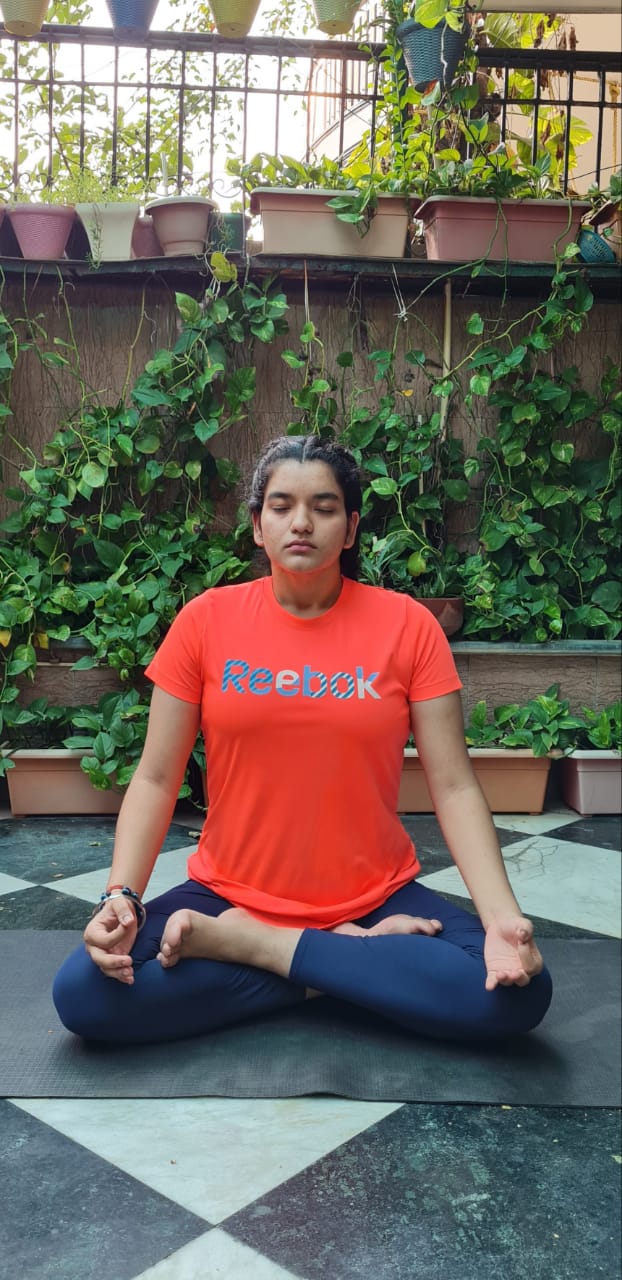
The term "Nadishoddhana" is a combination of two words "Nadi" meaning nerves or channel in which energu flows and "shodhana" means Purification. It is a complete process of nostril Breathing.
It is the exercise
- Of Alternate nostril breathing,
- Is Longer and Deeper and
- The level of Carbon dioxide is less in the body
How To Do?
- Sit in meditative posture.
- keep the spine and head straight and erect
- Slowly Close your eyes
- Adopt Jnanamudra, Placing the right hand on right knee and left hand on left knee
- Take 2-3 breath with both nostrils.
- Then adopt Nasikagra mudra (places the middle finger and forefinger at the point between the eyebrows. The thumb is used to close off the right nostril, and the ring finger is used to close off the left nostril.) and close the nostril with right thumb and inhale with left nostril.
- Press the left nostril and right little and ring finger.
- Exhale through right nostril
- Then again, inhale through right nostril closre right nostril, hold as per your capacity, then exhale through left nostril
- This is one complete round.
Benefits:
- Relaxes the whole body
- Maintains body temperature
- Create calmness and steadiness in mind and also improve concentration and focus.
- Provides sufficient oxygen to whole body, so that every cell functions properly
- Removes waste products from the bodyin the form of carbon-dioxide and other toxic gases
- Opens the nerve channels and removes the blockage from the body
- Releases accumulated stress in the mind and body effectively and helps to relax.
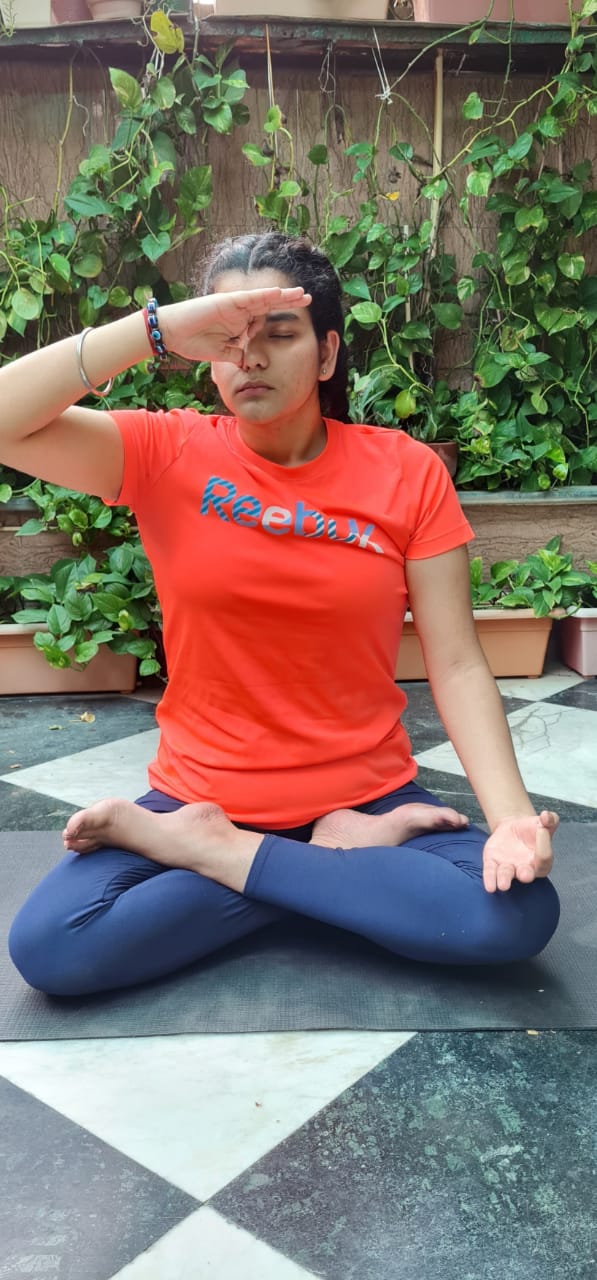
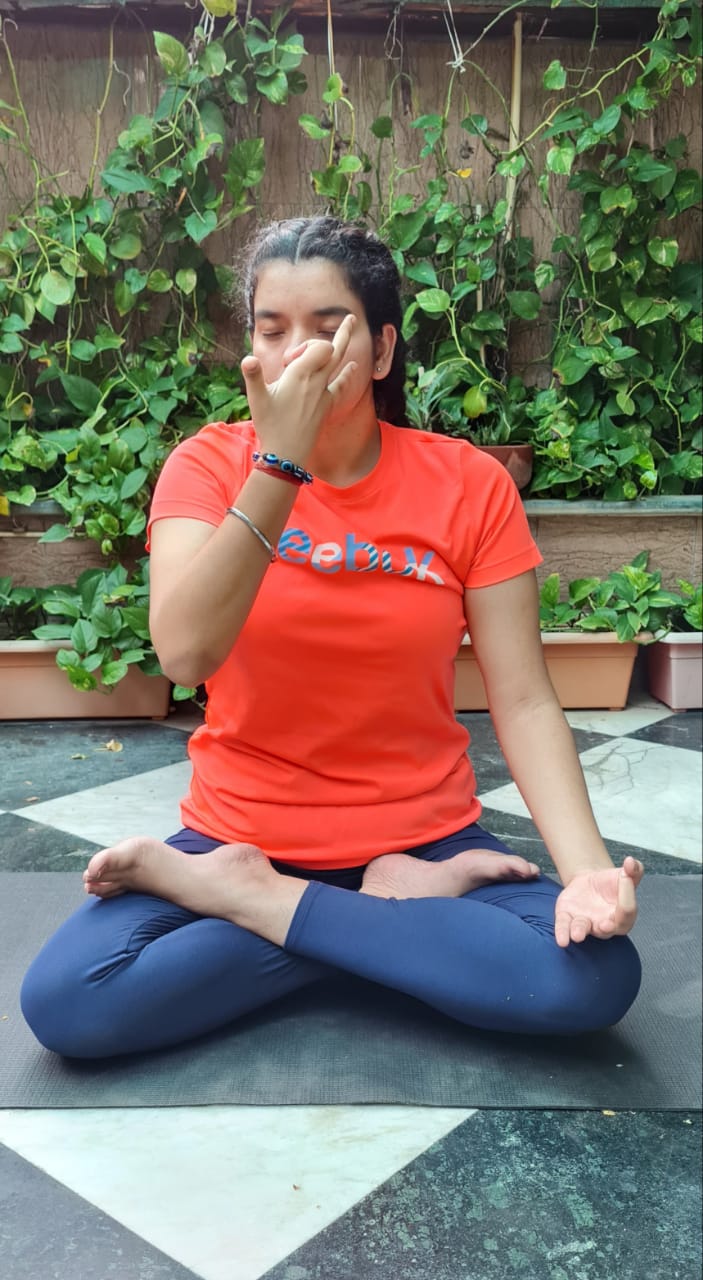
‘Kapala’ is a Sanskrit word; it means skull. ‘Bhati’ means to shine. The term ‘Kapalabhati’ means an exercise that makes the skull shine. This pranayama is used to ‘Purify’ the body, with all negativity and stress and making the nostrils and lungs in work . This exercise is also used for weight loss and a great exercise for breathing
How To Do?
- Sit in meditative posture.
- Close your eyes and relax the whole body.
- Inhale deeply through both nostrils and expand the chest.
- Expel the breath with forceful contractions of the abdominal muscles and relax.
- Continue active/forceful exhalation and passive inhalation.
Benefits:
- It cleanses the respiratory system and the nasal passages and removes the spasm in bronchial tubes. Consequently, Asthma is relieved and also cured in course of time.
- The apices of the lungs get proper oxygenation. Thereby they cannot afford favourable nidus (breeding grounds) for tubercle bacilli.
- Carbon dioxide is eliminated in a large scale.
- Impurities of the blood are thrown out.
- Tissues and cells absorb a large quantity of oxygen
- It is also used for weight loss
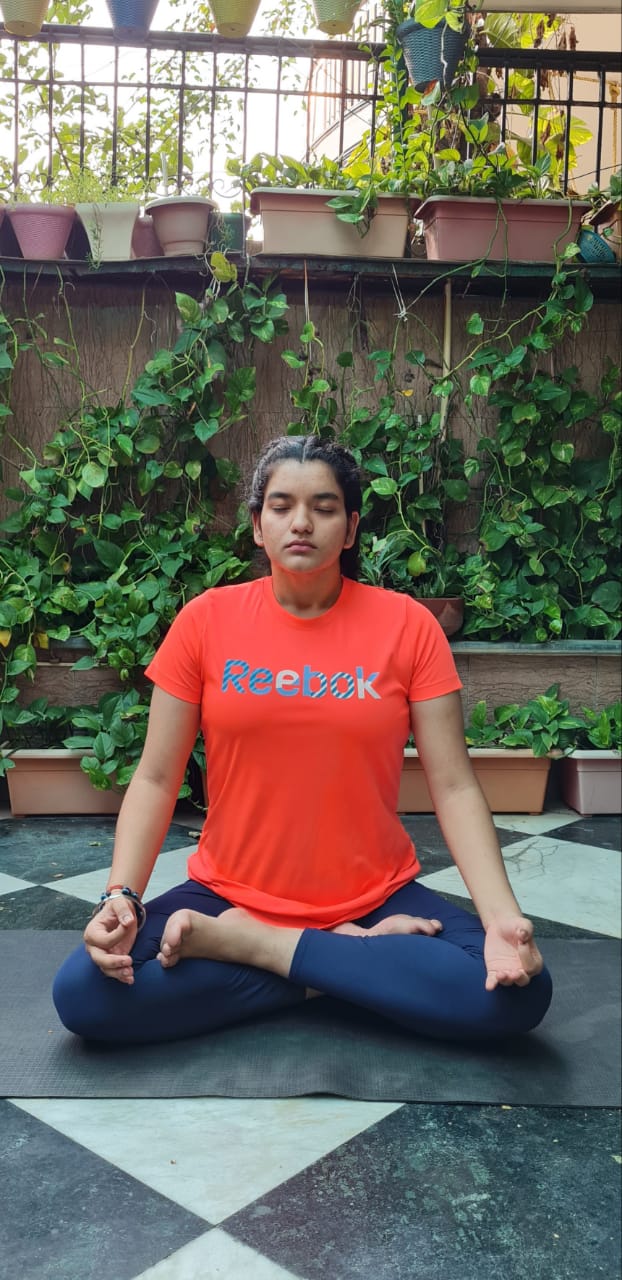
The Sanskrit word "Bhramari" comes from the word "Bhramara" which means a Black bee. While practicing it, a humming sound is produces throgh the nostrils that resembles with the buzzing sound of black bee. Bhramari pranayama is effective in instantly calming down the mind. It is one of the best breathing exercises to free the mind from all the stress, anxiety, anger, frustration and all the negative area and instantly calm the mind. It is the exercise for concentration and relaxation
How to do?
- Sit in meditative posture and keep the spine and neck straight.
- Place your index fingers on your ears right at the cartilage.
- Keep the mouth and eyes closed and inhale deeply
- While exhaling create a humming sound.
Benefits:
- Lowers the blood pressure, thus relieving Hypertension.
- Gives instant relief from tension, anger and anxiety.
- Helps mitigate migraines.
- Bolsters the health of the throat
- Strengthens and improves the voice
- Relieves stress and anxiety
- Induces Sleep
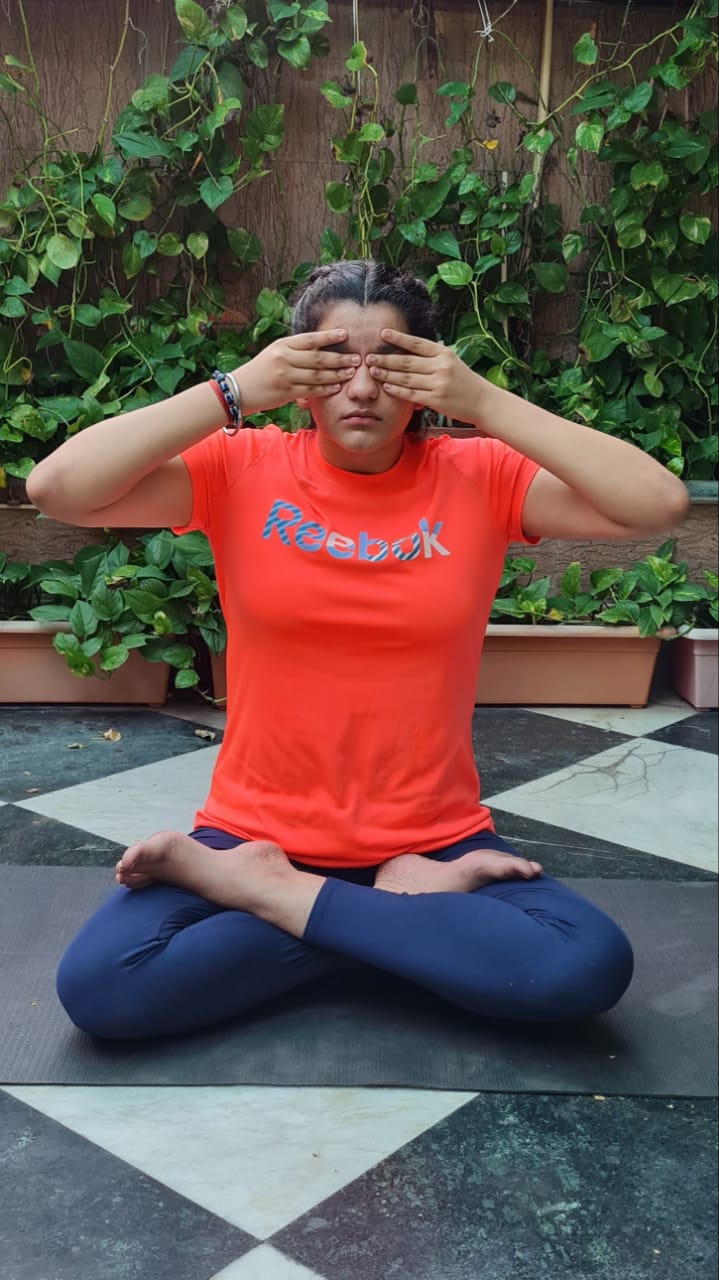
The Sanskrit word "Udgeeth" means “deep and rhythmic chant” hence this pranayama involves a deep and rhythmic chant of the divine syllable of OM, OM is the most perfect and complete name of the almighty eternal supreme soul (GOD) in the Vedic scriptures and ancient Indian tradition.
How To Do?
- Sit in meditative posture and keep the spine and Head errect.
- Put your hands on your thighs in Gyan Mudra.
- Take a deep inhale through your nose, untill your diaphragms get filled with air completely.
- slowly exhale the breath from your nose in a very slow manner. With the exhalation chant the ‘OM’ word.
- While chanting the word OM sound of O should be longer than M.
Benefits:
- It relaxes the mind and induces a meditative state.
- It calms the mind and is used to increase concentration.
- It even Helps people suffering from insomnia
- Helps to resolves Gas, acidity and other stomach diseases.
- The practice of this pranayama in Pregnancy leads to normal delivery.
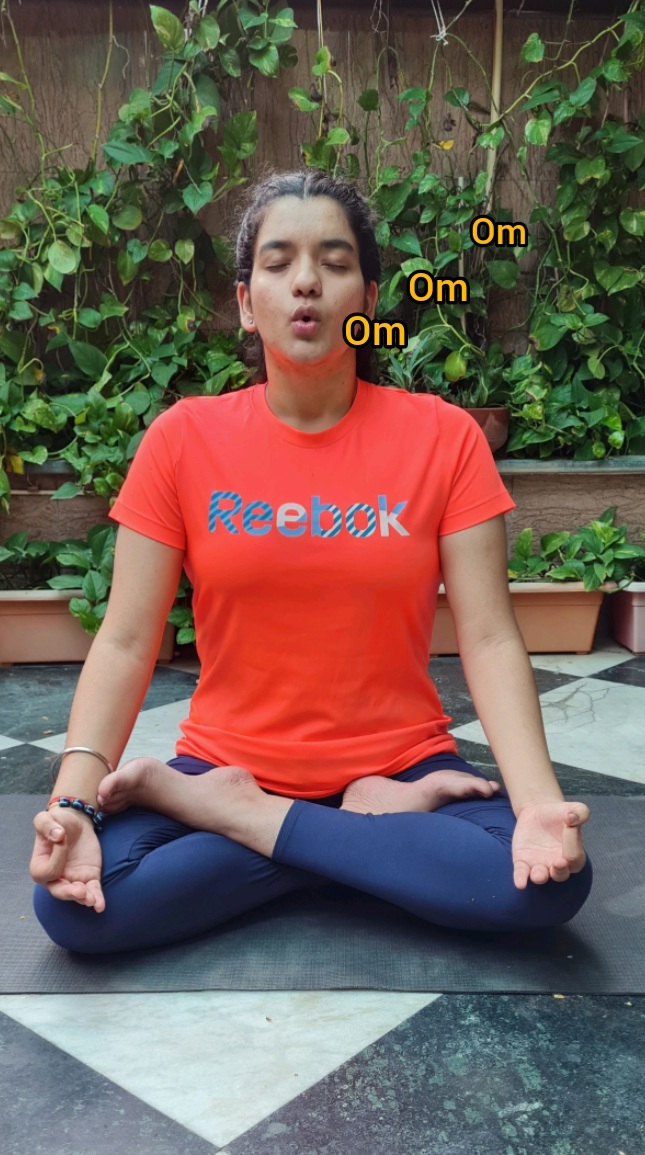
These 5 sitting excercises should be performed in daily basis to lead to stress free life and make our lungs strong
In simple words is the ability of an organism to fight against a particular infection or toxin by the action of specific antibodies or white blood cells or it is the ability of our body to fight disease-causing organisms is called immunity. The higher the immunity of a person the more he is free from different diseases.
To build up our immunity it is necessary for the WBC to be in high number. In building of immunity WBC plays a vital role. Together with WBC and B cells and T cells they build up the whole immune system and generate antibodies forming a defence mechanism against the infection.
Spleen and lymph nodes produces WBC there are several lymph nodes in our body like under our armpits [axilla],near our neck [cervical area] , at the pelvic area [inguinal region] ,if we know the technique of putting an impact over these area this will lead to increase the number of WBC naturally that will lead to increase the body’s defence mechanism and increase the overall immunity.
It helps in pumping more air to your lungs and improves the overall performance of the body. This asana is to It helps in strengthening your back muscles and increases the blood circulation of the body. This aasana also helps for the brain to be stress free and reduce anxiety level.
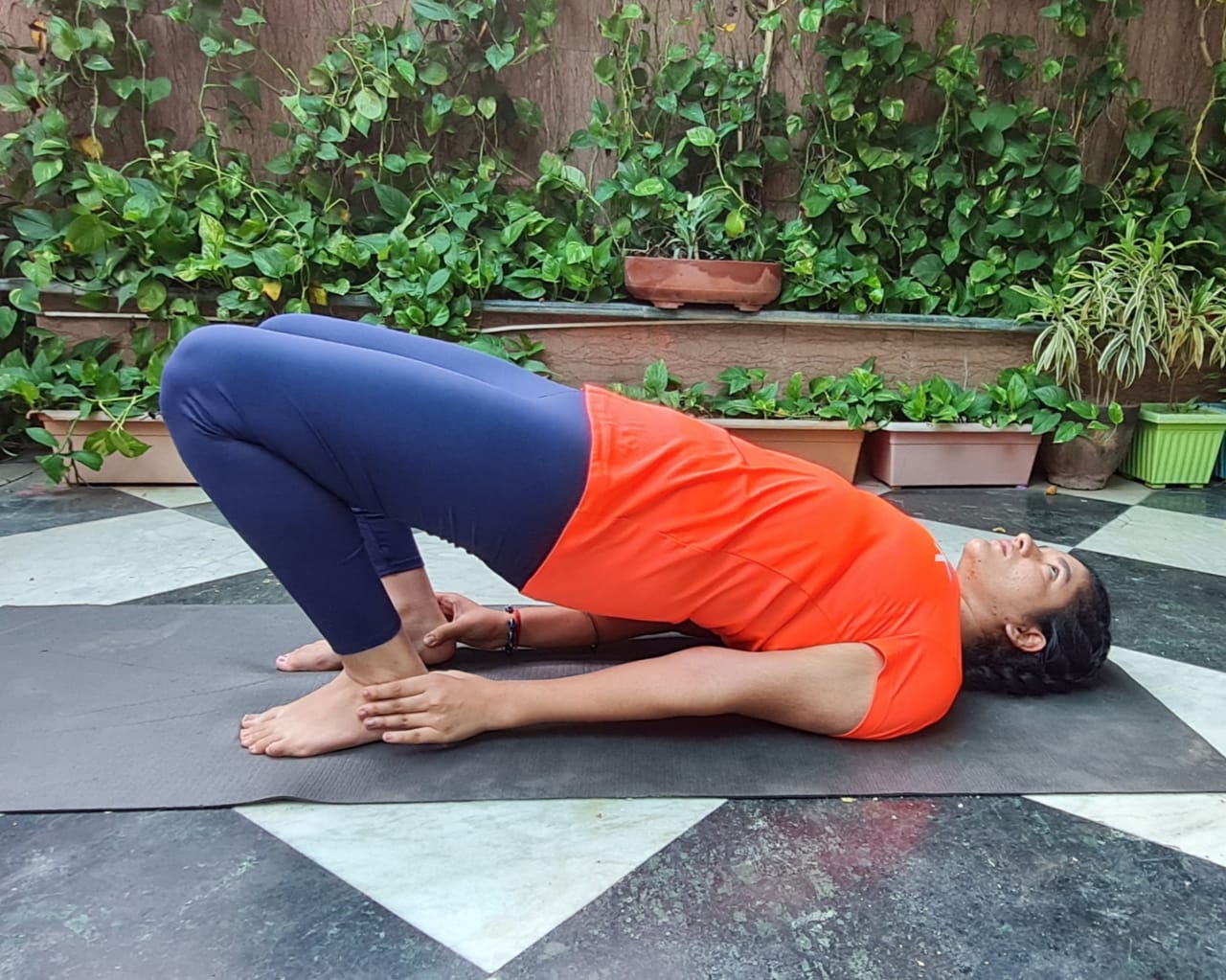
Sarvangasana means all Limbs. All the four limbs, the two arms and the two legs are involved in this asana. This asana is used to balance the of all parts of the body on the shoulders and upper part of our body and is known as the Queen of all the asana.
How to Do?
- Lie down in spine position
- Rest the hand beside the thigh with parms facing the ground.
- Inhale and start raising the legs.
- When the legs become 90 degree with the ground , then hold the waist with hands
- Start exhaling and raise the body above the shoulders
- In the final position, the body below the shoulder would be completely raised upward.
- Hold this position for 5-10 normal breaths and then slowly down to supine position.
Benefits:
- It helps to enhance the blood circulation and boost the overall immunity.
- Itis used to reduce high blood pressure.
- Tones the legs and buttocks
- Improved digestion
- Stretches the shoulder and neck.
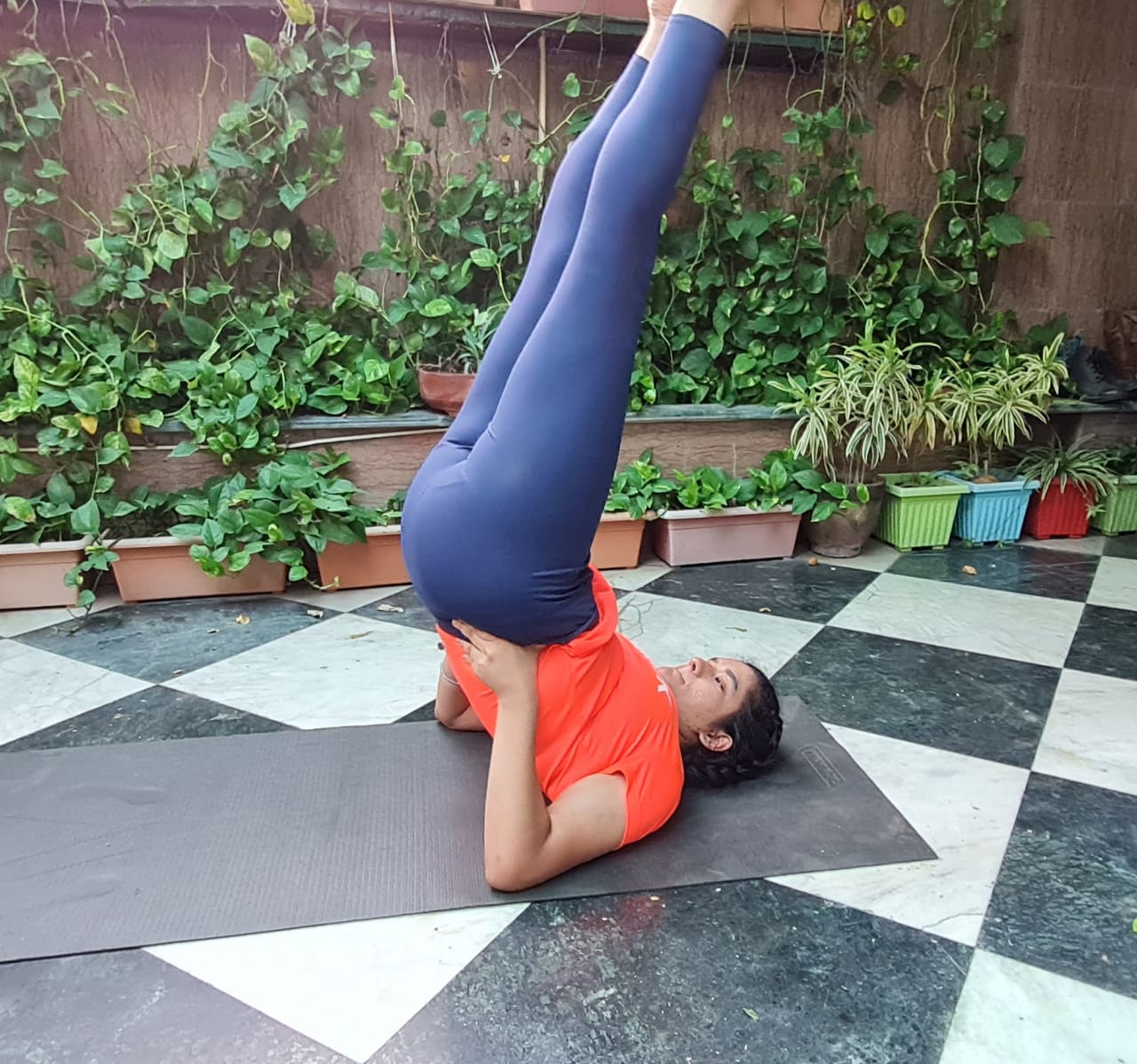
Hala is a sansrit word meaning an Indian Plough. This asana resembles the shape of a Plough. The body looks like the base while the legs are streached backwards like its shaft.
How to do?
- Lie down in Supine Position
- Rest the hands beside the hips with palms placed firmly on the ground.
- Lifting the feet from ground place them behind the head.
- The hands can be taken back behind the back to catch hold of the big toe.
- Keep Your eyes open and concentrate on the svadhishthana chakra
- Breathe normally for 5-10 breaths and then return to the supine position
Benefits:
- It makes the skine flexible, agile and strong
- The digestive and circulatory system are positively affected
- The motor and sensory neurons of central and peripheral nervous system are activated
- Extra fat over thigh muscles is removed.
- This asana activates the immune system as it improves the function of several glands and organs including spleen.
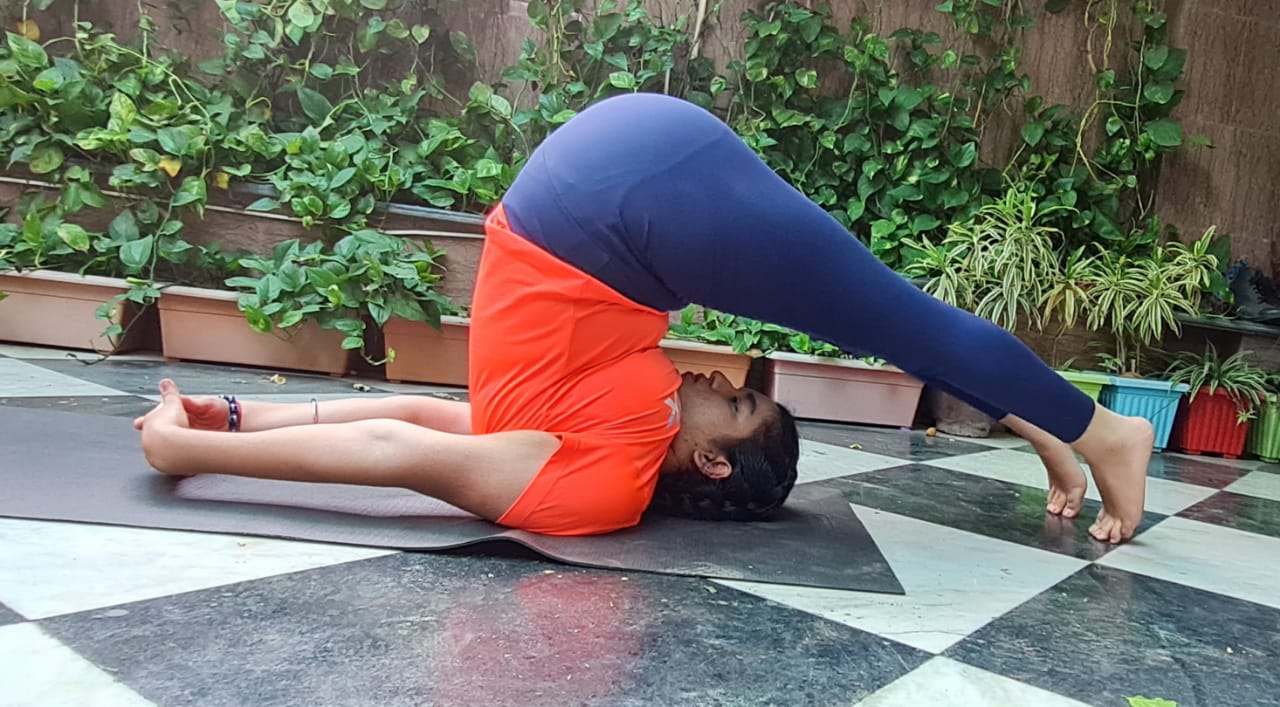
This asana is known for providing calmness to the mind, decreasing the level of anxiety, stress, depression and indulge the body and mind into meditation. It even helps the back and neck muscles and improves the overall bodys posture.
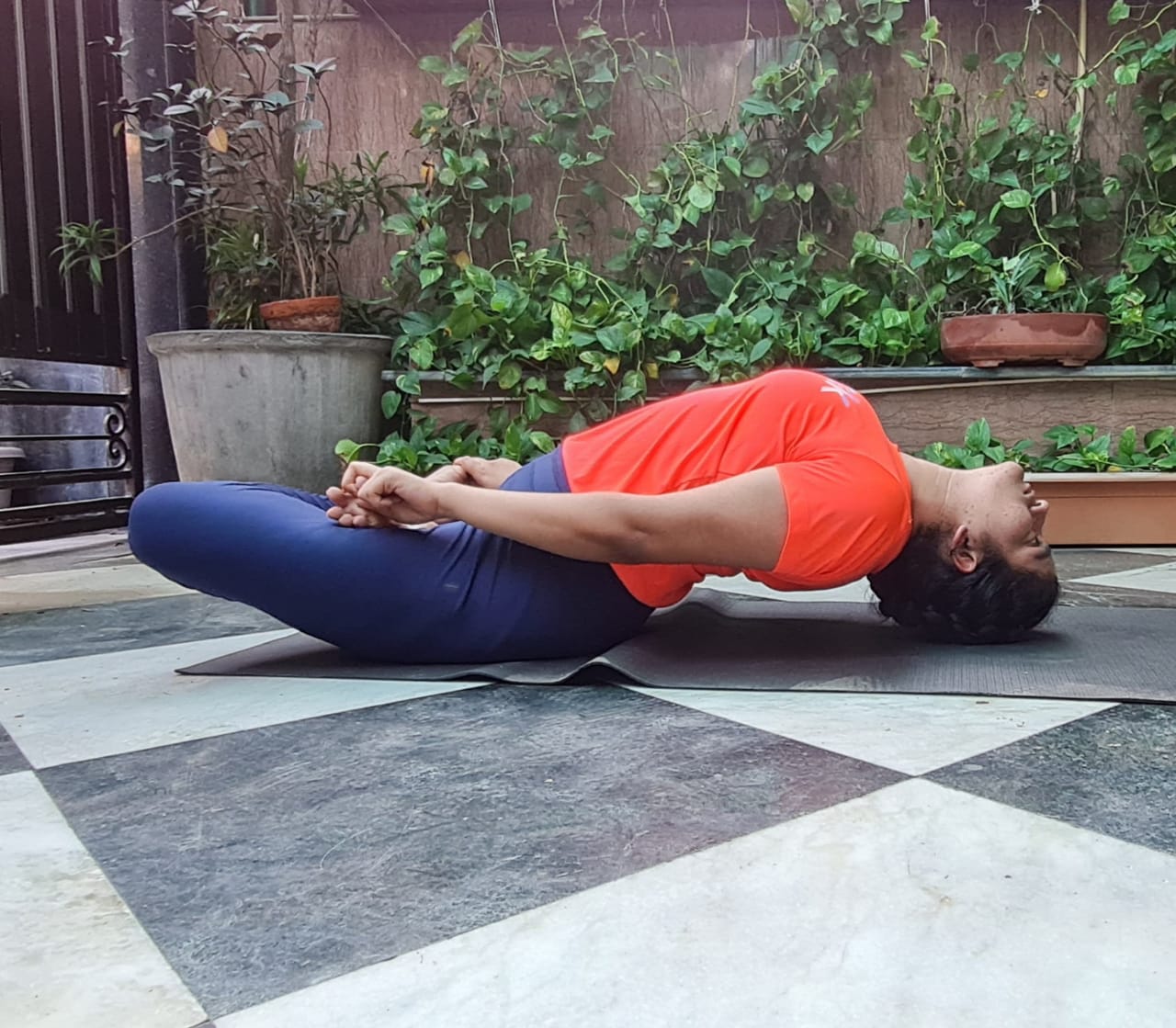
The 3 Major sources of energy on earth are wind, water and sun. Sun is the most powerful source of energy. Suryanamaskar consists of twelve steps and the practice of each step must be carried with the definied breathing pattern and concentration should be kept on the respective chakra. Along with it each step comes with a mantra which needs to be mentally recited during practise. This asana indulges the whole body and mind. It is a complete workout of the body. Doing suryanamasker on regular bases helps to provide a disease free life and healthy life.
Steps of Suryanamaskar:
Step 1: Pranamasana or Namaskaramudra
Breathing Pattern: Normal
How To Do?
- At the time od sunrise and sinset, stand erect facing the sun, ankles & toes should be joined together.
- Keep hands in Namaskara Position in front of the chest
- By standing in this manner, it creates an energy pathway, by which the body gets energised.
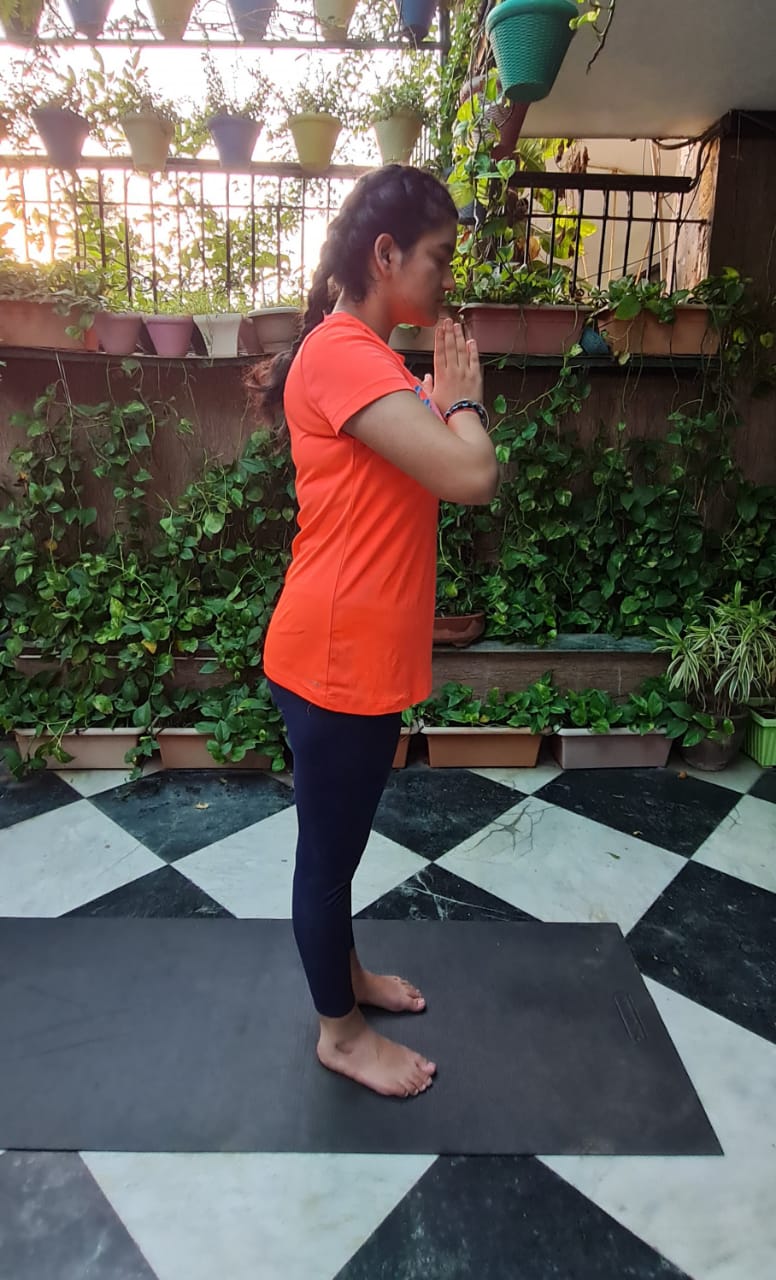
Step 2: Urdhvahastasana Hastottanasana
Breathing Pattern: Inhalation
How To Do?
- Inhale and bring arms behind the back without bending the elbows, head should be between the arms
- Retain the breath inside and gaze towards the sky and bend backwards as much as possible.
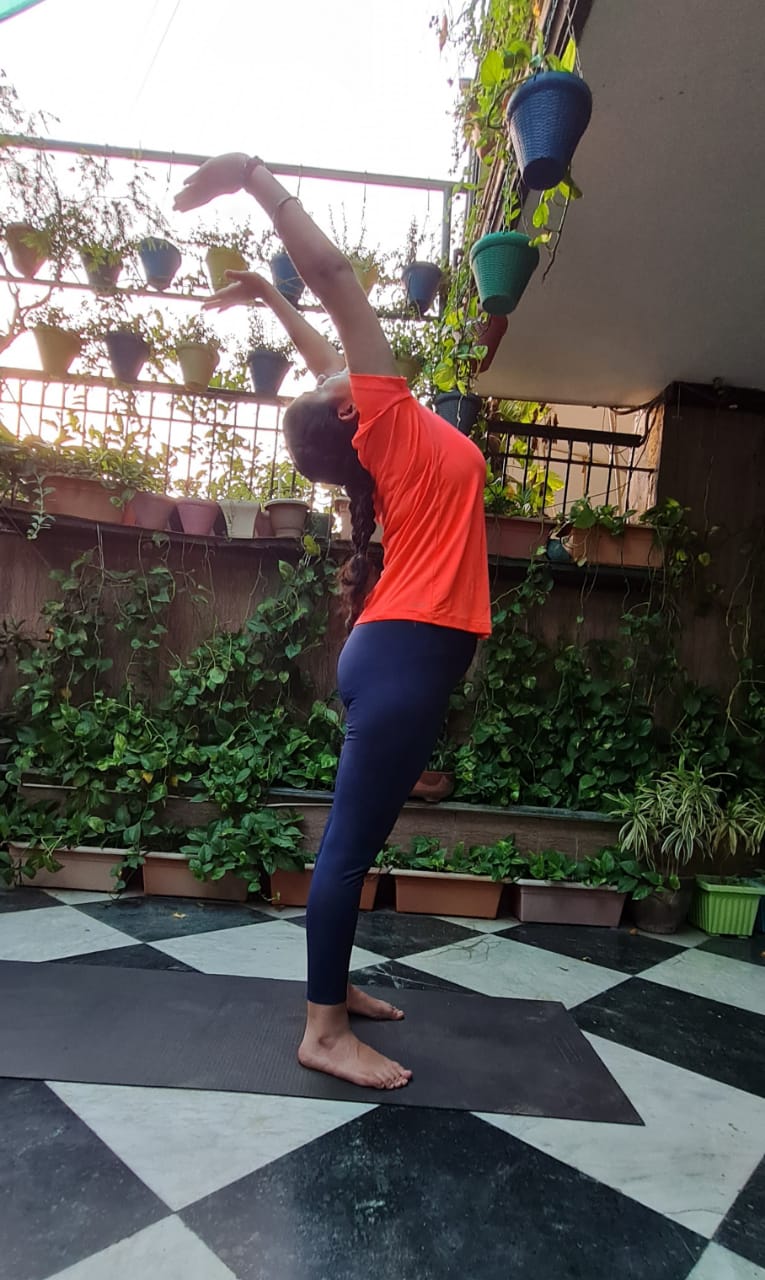
Step 3: Padahastasana
Breathing Pattern: Exhalation
How To Do?
- After the second position , with exhalation, bend forward. Keep palms on the ground besidwa the feet.
- Touch the knees with the head and keep in mind not to bend the knees
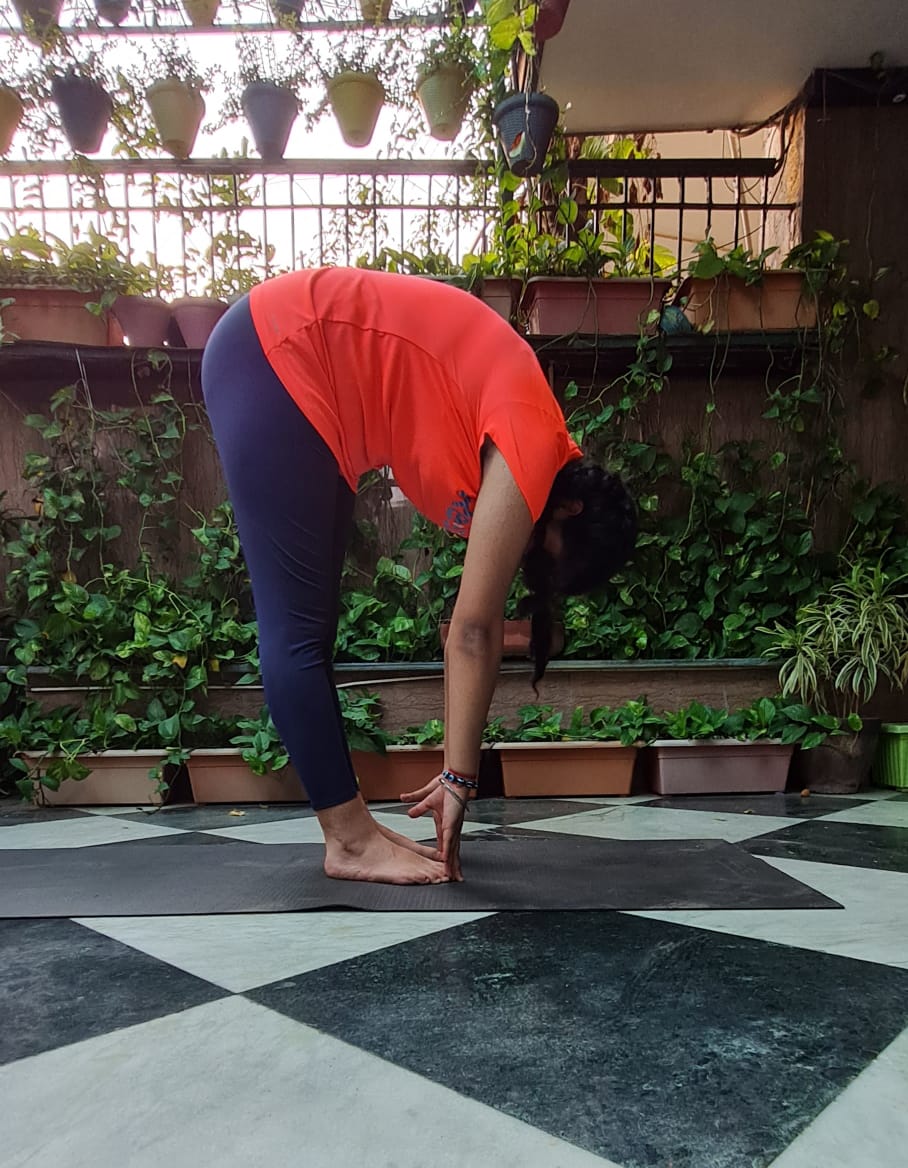
Step 4: Vama or Left-Ashvasa Chalanasana
Breathing Pattern: Inhalation
How To Do?
- After the third step, stretch the left foot backwards, the right leg should remain between the two hands
- Hold your breath, keep the right knee in front of the chest and gaze at the sky
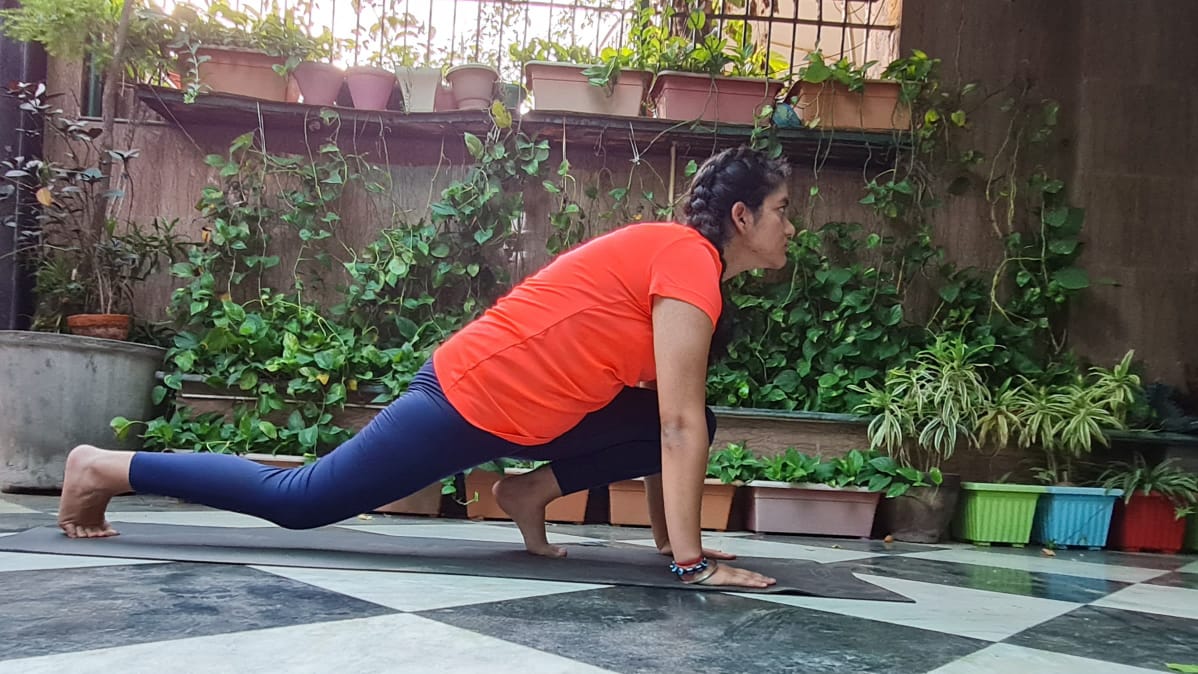
Step 5: Parvatasana or Mountain Pose
Breathing Pattern: Exhalation
How To Do?
- With exhalation stretch the right foot backwards next to the left foot
- Head should be between the hands, raising buttocks and waist, seeing the navel
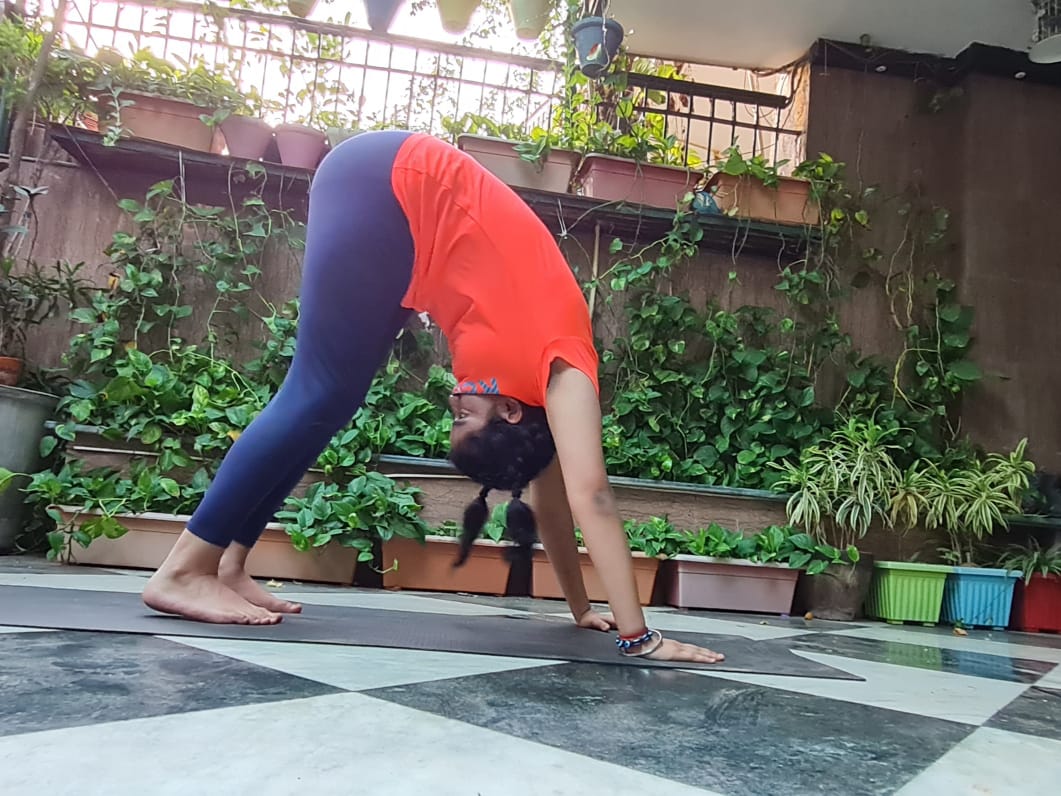
Step 6: Ashtanganamanasana/ Sashatangasana/ Adhomukhashavasana
Breathing Pattern: Normal Inhalation-Exhalation
How To Do?
- Bend forward & touch the ground with your chest and knees by keeping the hands and toe firm.
- This way both the palms, feet, Knees, Chest and chin; these eight parts should be in contact with the ground, that is why this is called Ashtangasana/ Adhomukhasavasana.
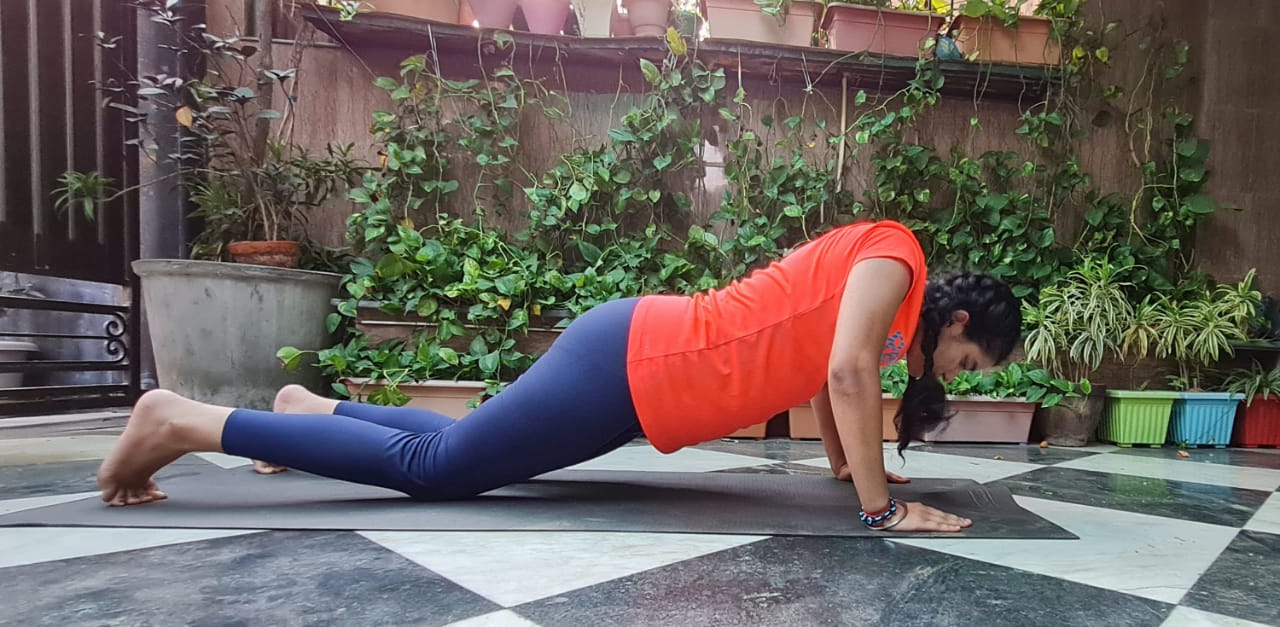
Step 7: Bhujangasana
Breathing Pattern: Inhalation
How To Do?
- With inhalation rise the chest slowly and straighten the arms
- Both the legs should be joined and stretch backwards
- The part of the body below the navel should touch the ground and the eyes directed towards the sky
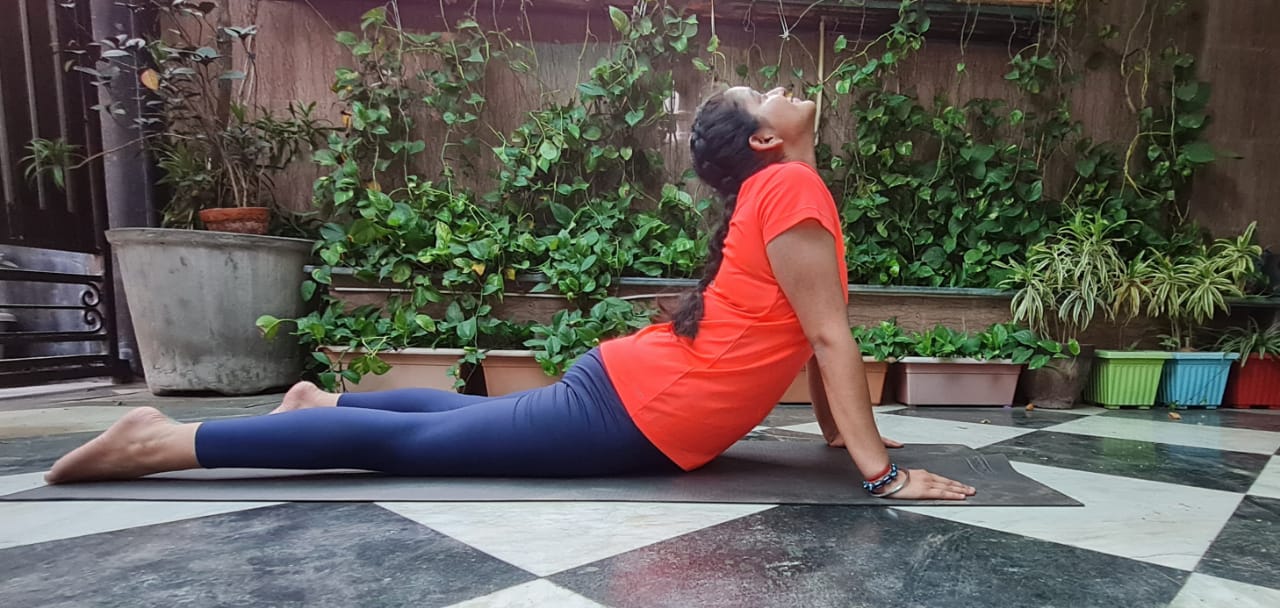
Step 8: Parvatasana or Mountain Pose
Breathing Pattern: Exhalation
How To Do?
- While exhalation lift the buttocks upwards. This way the shape of the body would become like a mountain
- Lower down the head to see the navel
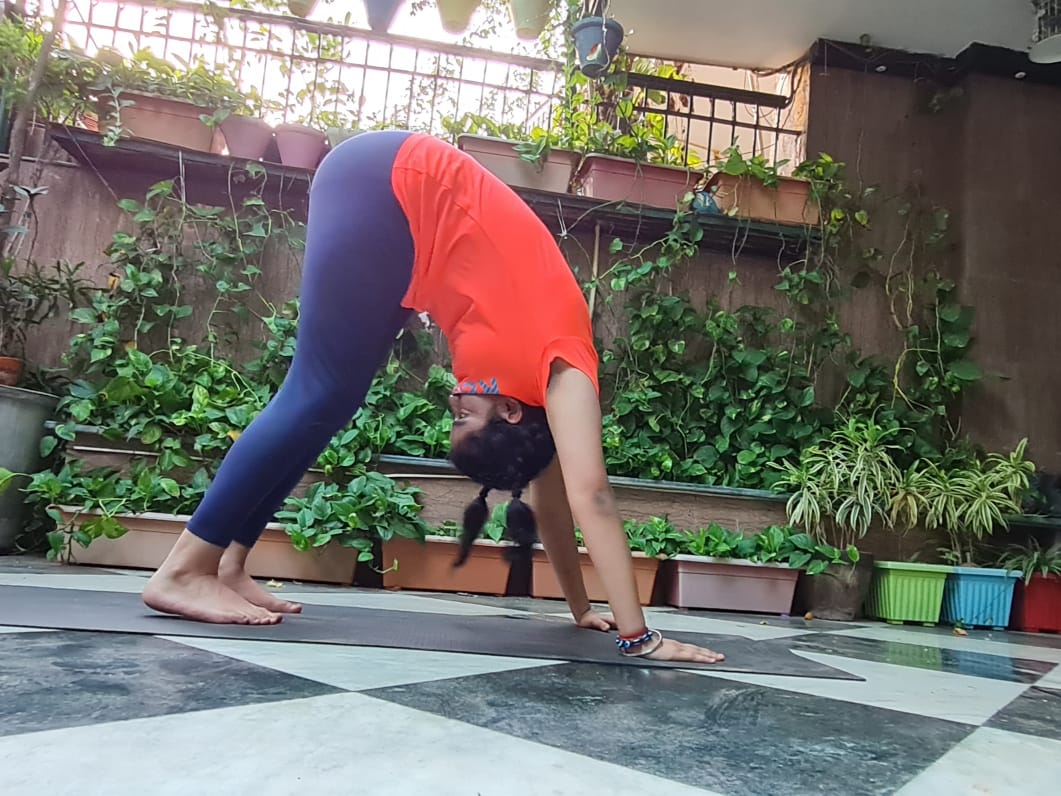
Step 9: Dakshina or Right-Ashvasanchalan Asana
Breathing Pattern: Inhalation
How To Do?
- After setep-8, with inhalation pull the left leg forward and place it beside the left hand. The right leg will remain backward in its earliest position.
- The left knee should be placed in front of chest and eyes directed towards the sky.
- Retain the breath as in step 4
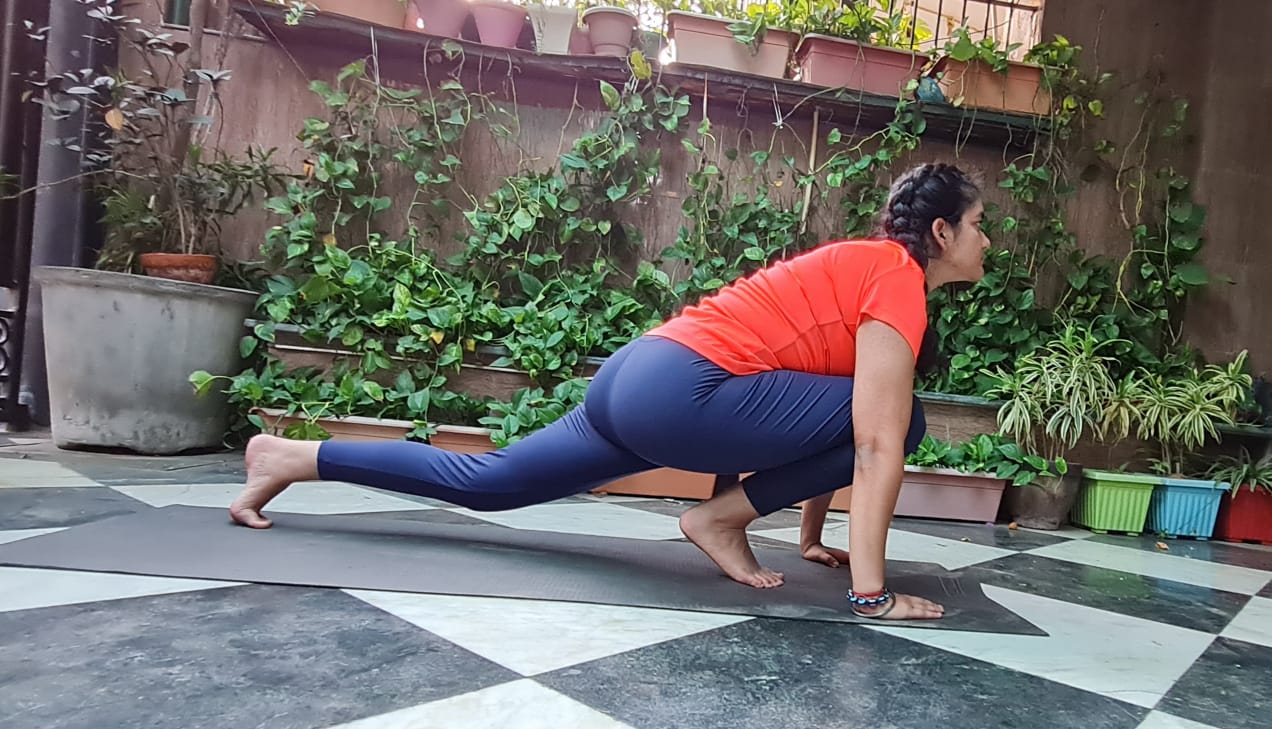
Step 10: Padahastasana
Breathing Pattern: Exhalation
How To Do?
- After the 9th Position, with exhalation pull the right leg forward and place it inside of right hand. Both the left and right feet should be touching each other.
- Simultaneously, raise the buttock and knees with the head. Keep in mind that in any situation knees should not be bend.
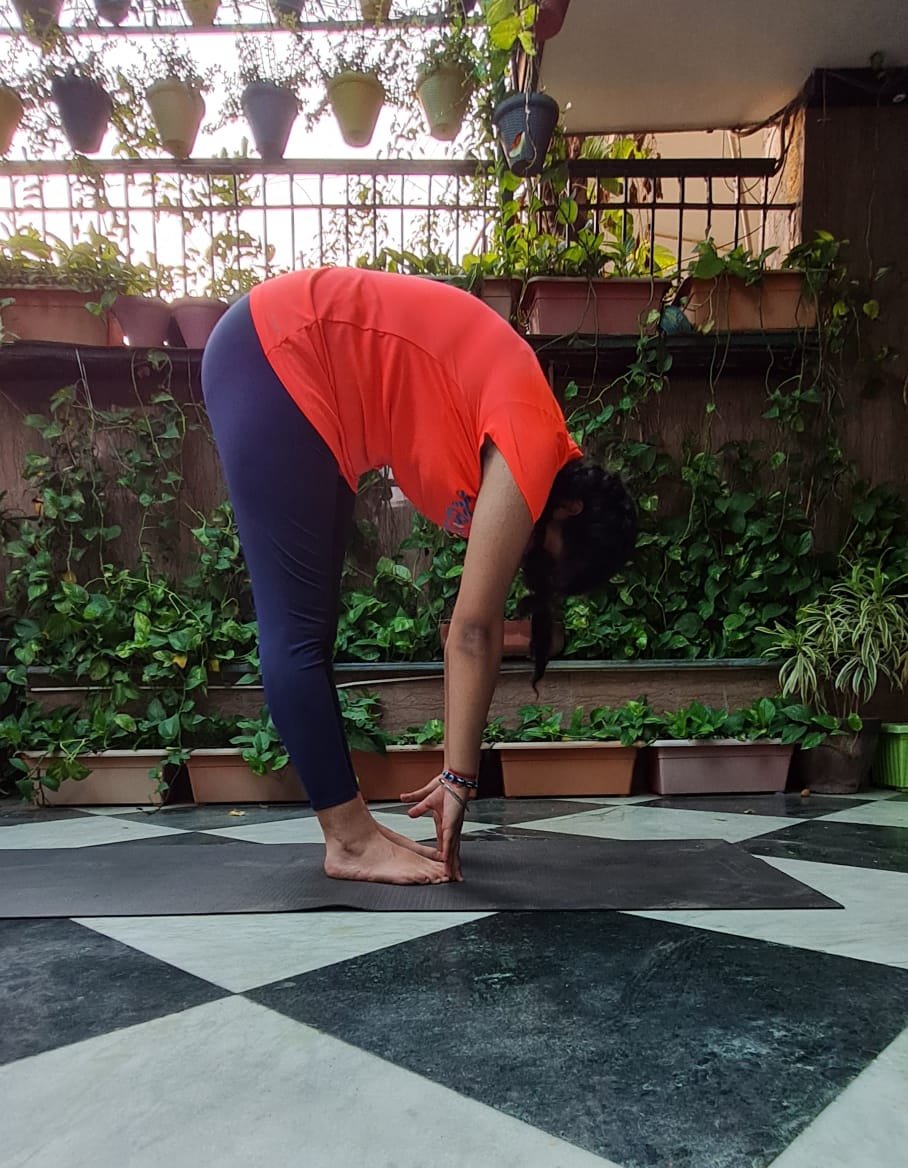
Step 11: Urdhvahastasana/ Hastottanasana
Breathing Pattern: Inhalation
How To Do?
- With inhalation, raise the arms and take them behind the back, without folding the elbows
- Head should be placed between the arms while retaining the breath
- Gaze at the sky and bend backwards from the waist.
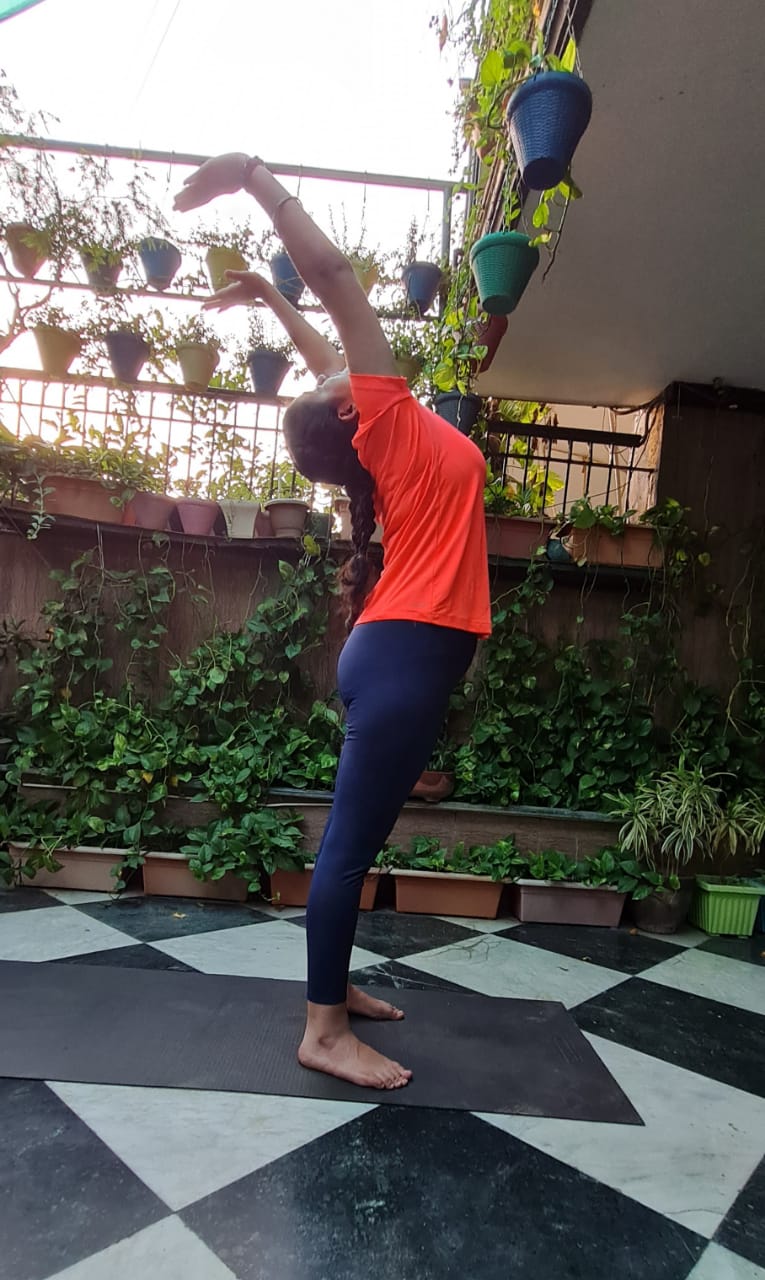
Step 12: Pranamasana
Breathing Pattern: Normal Inhalation and Exhalation
How To Do?
- Return to the standing position with heels and toes joined toether
- Join the palms and place them in front of chest in namaskara position
- Maintain normal breathing as in step 1
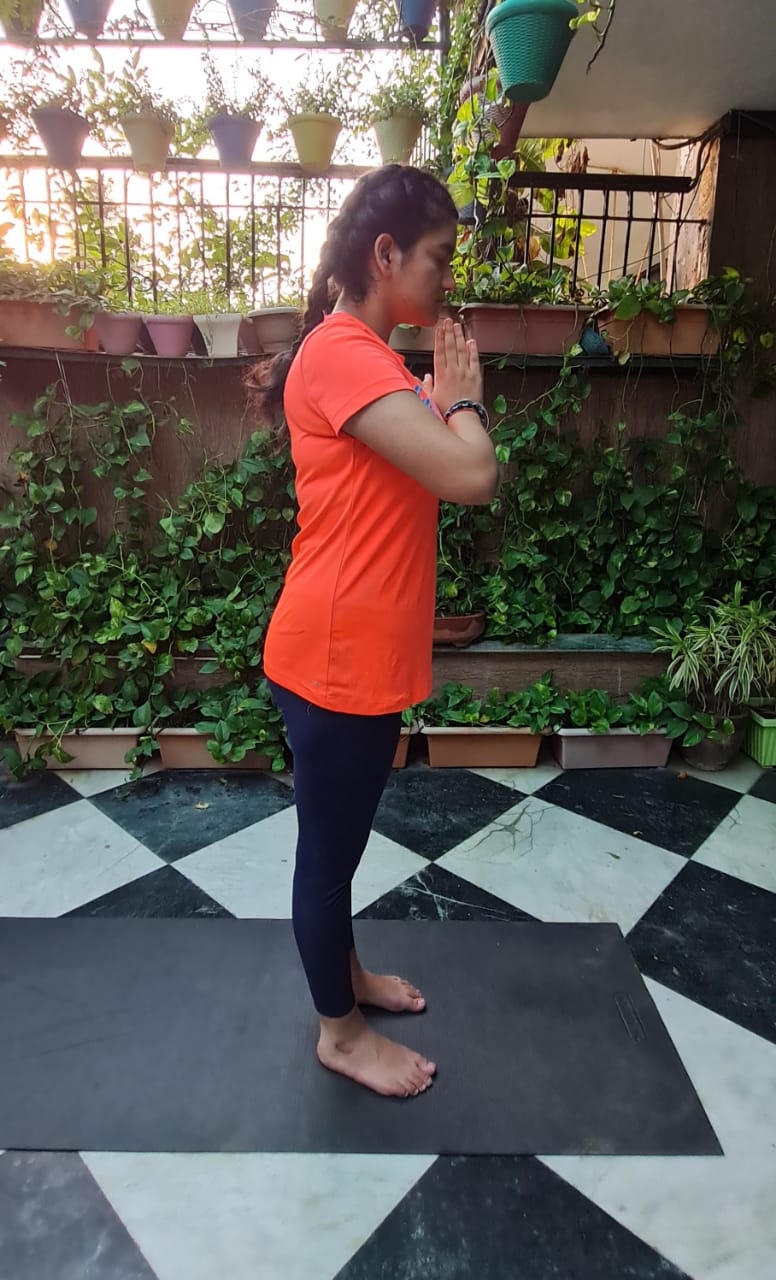
Benefits of Suryanamaskar:
- Suryanamaskar is a complete exercise. It makes all the organs strong and healthy
- It keeps the stomach, Intestines, abdomen, pancreas, heart and lungs healthy.
- It makes the spine and back muscles flexible, It helps to improve the deformities in them
- It establishes proper blood circulation in the entire body. It is also useful to remove the impurities in blood and cure the skin diseases
- Provides longevity, sound health
- It gradually brings positive stimulation on the endocrine glands
- It increases Basal Metabolic Rate (BMR)
Get the Latest Updates Blog
 Click here to Pay
Click here to Pay
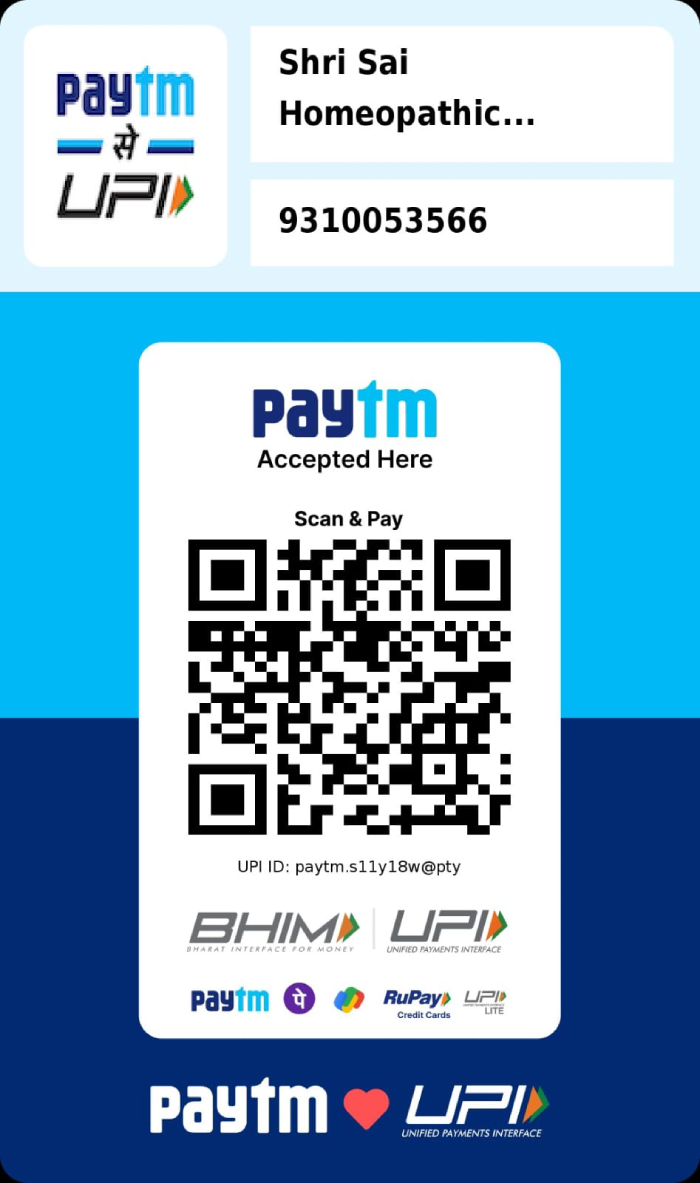
Please send the screenshot at 880 090 0271

